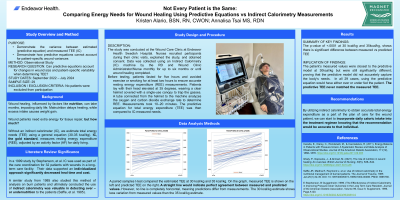Clinical Research
(CR-002) Not Every Patient Is the Same: Comparing Energy Needs for Wound Healing Using Predictive Equations vs. Measured Using Indirect Calorimetry
Friday, May 2, 2025
7:45 PM - 8:45 PM East Coast USA Time

Annalisa Tsai, MS, RDN
Introduction: The purpose of this study was to validate the use of an Indirect Calorimetry (IC) reading to determine a more accurate picture of the caloric need per individual patient with a goal of wound healing. We hypothesized that the "one-size-fits-all" predictive equation of 30-35 kcal/kg would not match the patient's measured resting and total energy expenditures (REE/TEE).
Methods: Participants needed to have a chronic wound. After a 5 hour fast, they completed an IC reading monthly for a minimum of 2 measurements and up to healing. The machine would analyze the carbon dioxide and oxygen exchange rate to determine the resting energy expenditure. The reading would take 10-20 minutes. REE was then multiplied by an activity factor based on individual lifestyle (0.1 for normal daily activities - 0.2 for moderate exercise) to provide a measured TEE.
Results: The resulting data showed that there was a significant difference in the measured TEE vs. the predictive equation. The predictive equation in every case either over- or under-estimated the patient's calorie needs; in most cases it grossly over-estimated the patient's need. The predictive equation of 30 kcal/kg was the closest to the measured TEE, however it was still more than the patient actually needed.
Discussion: We concluded from our study that the IC should be a tool utilized in the outpatient setting to give our patients a more individualized plan of care. Additionally, through the process we discovered that most patients had no understanding of how nutrition played a role in healing. This ultimately lead our Wound Clinic to to hiring a dietitian as part of the staff who is now part of every patient's plan of care with us.
Methods: Participants needed to have a chronic wound. After a 5 hour fast, they completed an IC reading monthly for a minimum of 2 measurements and up to healing. The machine would analyze the carbon dioxide and oxygen exchange rate to determine the resting energy expenditure. The reading would take 10-20 minutes. REE was then multiplied by an activity factor based on individual lifestyle (0.1 for normal daily activities - 0.2 for moderate exercise) to provide a measured TEE.
Results: The resulting data showed that there was a significant difference in the measured TEE vs. the predictive equation. The predictive equation in every case either over- or under-estimated the patient's calorie needs; in most cases it grossly over-estimated the patient's need. The predictive equation of 30 kcal/kg was the closest to the measured TEE, however it was still more than the patient actually needed.
Discussion: We concluded from our study that the IC should be a tool utilized in the outpatient setting to give our patients a more individualized plan of care. Additionally, through the process we discovered that most patients had no understanding of how nutrition played a role in healing. This ultimately lead our Wound Clinic to to hiring a dietitian as part of the staff who is now part of every patient's plan of care with us.

.jpg)